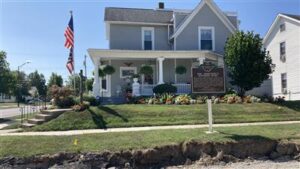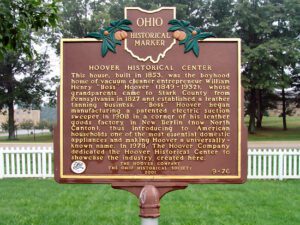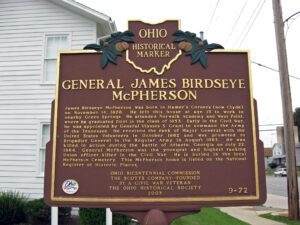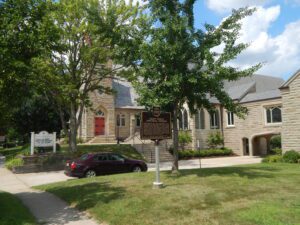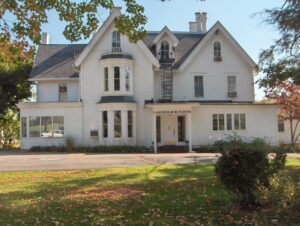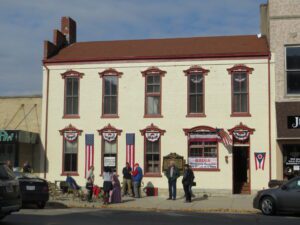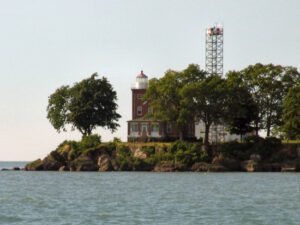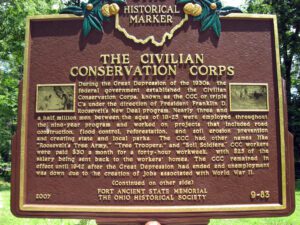, OH
Stephen and Viola Armstrong moved their family, including 13-year-old Neil and his younger siblings, June and Dean, to the house at 601 West Benton Street in 1944. Here, Neil explored his fascination with flying by reading aviation magazines and building model airplanes. Neil completed flying lessons at nearby Port Koneta airport and earned his pilot’s license on his sixteenth birthday, even before receiving a driver’s license. Neil graduated from Blume High School in 1947 and studied aeronautical engineering at Purdue University on a Navy scholarship. The Korean conflict interrupted his studies, but he left the Navy as a decorated combat pilot, flying 78 missions. After graduating from Purdue in 1955, Neil worked at what would become the NASA Glenn Research Center in Cleveland. Soon after he became a test pilot at Edwards Air Force Base in California. (Continued on other side)
, OH
This house, built in 1853, was the boyhood home of vacuum cleaner entrepreneur William Henry “Boss” Hoover (1849-1932), whose grandparents came to Stark County from Pennsylvania in 1827 and established a leather tanning business. “Boss” Hoover began manufacturing a patented electric suction sweeper in 1908 in a corner of his leather goods factory in New Berlin (now North Canton), thus introducing to American households one of the most essential domestic appliances and making Hoover a universally-known name. In 1978, The Hoover Company dedicated the Hoover Historical Center to showcase the industry created here.
, OH
James Birdseye McPherson was born in Hamer’s Corners (now Clyde) on November 14, 1828. He left this house at age 13 to work in nearby Green Springs. He attended Norwalk Academy and West Point, where he graduated first in the class of 1853. Early in the Civil War, he was appointed by General Ulysses S. Grant to command the Army of the Tennessee. He received the rank of Major General with the United States Volunteers in October 1862 and was promoted to Brigadier General in the Regular Army in August 1863. He was killed in action during the battle of Atlanta, Georgia on July 22, 1864. General McPherson was the youngest and highest ranking Union officer killed in the Civil War. He is buried in the local McPherson Cemetery. This McPherson home is listed on the National Register of Historic Places.
, OH
On March 11, 1817, Rev. Roger Searle of Connecticut met with a group of settlers at the home of Zenas Hamilton in Medina Township and founded St. Paul’s Episcopal Church. On April 10, 1817, the congregants cleared land near Weymouth and built a log church, which served as a school, place of worship for other dominations, and meeting house. The congregation eventually moved to Medina to serve the village’s growing population. Around 1883, noted Detroit architect Gordon W. Lloyd designed a new church in the Victorian Gothic style, thereafter described as “incomparably the finest Episcopal church in any country town at the time.” The first service was held on December 19, 1884. St. Paul’s was listed on the National Register of Historic Places in 1982 and is the oldest congregation in Medina County still in existence.
, OH
Lakeholm was built as the home of Columbus Delano while serving as Secretary of the Interior under President Ulysses S. Grant from 1870 to 1875. Delano (1809-1896) came to Mount Vernon in 1817, attended public schools, studied law, and was admitted to the bar in 1831. In addition to practicing law in Mount Vernon and serving as the Prosecuting Attorney of Knox County, Delano was a farmer, mill owner, and politician. Lakeholm, originally part of a 300-acre farm, contains many of its original rooms and Italianate features. In 1966, 209 acres of the farm were acquired for the establishment of the Mount Vernon Nazarene College. The house served as offices, meeting rooms, and classrooms. In 2002, the college became a university and continues to use Lakeholm for administrative offices. Historic Lakeholm is a focal point on the Mount Vernon Nazarene University campus and a symbol of the institution’s ties with the Mount Vernon community.
, OH
This mid-19th-century structure, built in the Federal style with Italianate detail added later, was once owned by town pioneer and merchant Cornelius Van Ausdal. It was later the home of his daughter Lucinda, her husband Joseph Donohoe, and their four children. Presidential candidate William Henry Harrison reportedly stayed here while he was in Eaton to deliver a campaign speech on September 8, 1840. Lucinda Donohoe reputedly also hosted circuit-riding preachers here and owned the area’s first piano. From 1938 to 1966, this building housed Mrs. Wagner’s Colonial Kitchen, a nationally recognized restaurant.
, OH
Constructed and first lit in 1897, the South Bass Island Light was in continuous operation until 1962 when the U. S. Coast Guard built an automated light tower to replace it. Significant for its contribution to transportation and commerce on Lake Erie, the South Bass Island Light was built to safely guide vessels through the crowded South Passage. Although many light stations were constructed with a dwelling as a separate structure, the keeper’s dwelling of the South Bass Light was attached to the 60-foot tower. The dwelling was designed in the Queen Anne style with red brick laid in Flemish bond. Outbuildings, a barn and oil house, were built in 1899. In 1967, The Ohio State University acquired the property for support of the F. T. Stone Laboratory programs for research, education, and outreach. South Bass Island Light was placed on the National Register of Historic Places in 1990.
, OH
During the Great Depression of the 1930s, the federal government established the Civilian Conservation Corps, known as the CCC or triple C’s under the direction of President Franklin D. Roosevelt’s New Deal program. Nearly three and a half million men between the ages of 18-25 were employed throughout the nine-year program and worked on projects that included road construction, flood control, reforestation, and soil erosion prevention and creating state and local parks. The CCC had other names like “Roosevelt’s Tree Army,” “Tree Troopers,” and “Soil Soldiers.” CCC workers were paid $30 a month for a forty-hour workweek, with $25 of the salary being sent back to the workers’ homes. The CCC remained in effect until 1942 after the Great Depression had ended and unemployment was down due to the creation of jobs associated with World War II.


